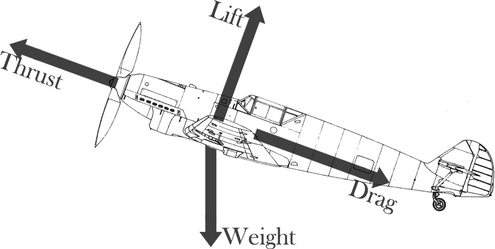Steady flight is defined as flight with no net acceleration. This means the forces of lift, thrust, drag and weight all cancel out and the plane is left to fly at a constant velocity whether this is level flight, a climb or a shallow dive.
Do not assume a heavy plane is slower than a lighter plane. Mass affects your acceleration, not your top speed. Only your thrust (which is sort of fixed) and your drag (which increases dramatically with airspeed) determines your top speed. Heavy planes are generally heavy because they are carrying massive engines which means their power to weight ratio is comparable to lighter planes, and that heavy engine and comparable shape and size (drag) means they generally have a higher top speed.

Acceleration[]
A plane will accelerate until the four basic forces in flight reach an equilibrium.
How fast a plane accelerates depends on its power-to-weight ratio at low speeds and aerodynamics at higher speeds
Steady level flight[]
The speed a plane reaches while flying level is simply the speed at which thrust and drag balance each other out.
Horizontal speed (and to some extent acceleration) is of importance to players intending to extend horizontally, that is 'run away'. It should be noted that bombs contribute to drag and can lower your top speed by about 20km/h, rockets seem to contribute little if any drag.
Speed vs Altitude[]
Air gets thinner with altitude. Although the power of an engine decreases with thinner air, with the help of a supercharger (compressor) of some sort, the thrust doesn't decrease as much as air density.
Since air density is dropping, drag is also dropping and therefore max speed is increasing.
At which altitude a plane reaches its peak speed depends on the performance of the supercharger.
Steady climbing flight[]
Climb is possible due to the power available after the power required to keep a plane afloat is consumed.

A lot of people think the plane should be pitched up as far as possible, flying at near stall speeds to climb faster. This is untrue, flying at such an extreme does two things
- It pitches the plane up and negatively affects the amount of drag as you approach stall angle/speed
- as you can see in the diagram, angling your plane upwards makes your weight act against your thrust; whilst this is inevitable in a climb, at extreme flight angles too much of the weight is being taken up by the thrust as the direction of lift and weight increasingly changes
Most planes climb best at a relatively shallow angle at an airspeed between 230 and 280 km/h, depending on the plane.
Gaining altitude quickly is important in terms of tactics as it ensures you are at least not at a distinct energy disadvantage when you meet the enemy or hopefully even gives you an energy advantage you can use.
In War Thunder since the maps are relatively small it is a good idea to try to reach sufficient altitude before encountering the enemy, that is to say, attempt to maximize altitude gained over distance rather than over time. This can be achieved by:
- Flying an indirect route in order to have more time to climb before reaching the front
- Deploying flaps to lower the speed at which you approach the front but increase your rate of climb
- Climbing at a slightly higher angle (and lower speed) than recommended for max rate of climb
For best performance, as you gain altitude, you should also lower your airspeed slightly to compensate for thinner air and weaker engine performance.
Zoom climb[]
A zoom climb is not a steady climb and the same rules do not apply as steady climbing:
- Flaps should not be deployed since your climb is mostly due to converting airspeed into altitude, not so much a function of your wings, deploying flaps merely increases drag and bleeds energy
- A high climbing angle should be chosen (around 40 degrees) so as to convert your energy into potential energy as quickly as possible to minimize loss to drag (the more time you spend above your steady speed the more energy you're losing to drag)
Steady descending flight (Gliding flight)[]
Gliding is steady flight without thrust from an engine, in War Thunder usually happens after a bad engagement with the enemy. The goal should be to ideally make it all the way back to a friendly base to land for repairing or at least glide far enough to make it to an empty field to set down on safely. (Use the virtual cockpit to see your flight vector/path to see if you will make it base or not.)
In a glide, gravity and lift (since the plane is usually at a negative flight angle to maintain speed) must counter drag. All effort must be done to make the aircraft as aerodynamically clean as possible, landing gear should be up until the last moment and if controllable, radiator flaps should be closed (your engine is dead anyway) and propeller should be feathered so as to create as little drag as possible. Rockets and bombs should be ditched for improved aerodynamics as well.
Flaps[]
A plane's glide path is defined by its lift-to-drag ratio. Different types of flaps affect the lift-to-drag ratio of a plane differently. However, it's not a simple matter and whether flaps should be deployed or not depends on the design of the plane and wings.
As a general rule of thumb:
- Split flaps should be avoided as they create excessive drag compared to plain flaps
- Special flaps such as Junkers flaps or Fowler flaps generally excel at generating lift for little drag so should be deployed
- Flaps should only be deployed up to ~20 degrees (usually combat setting)
- Plane with a single flap setting at a large angle such as the 80 degree settings on Spitfires should be avoided as they create excessive drag like spoilers.